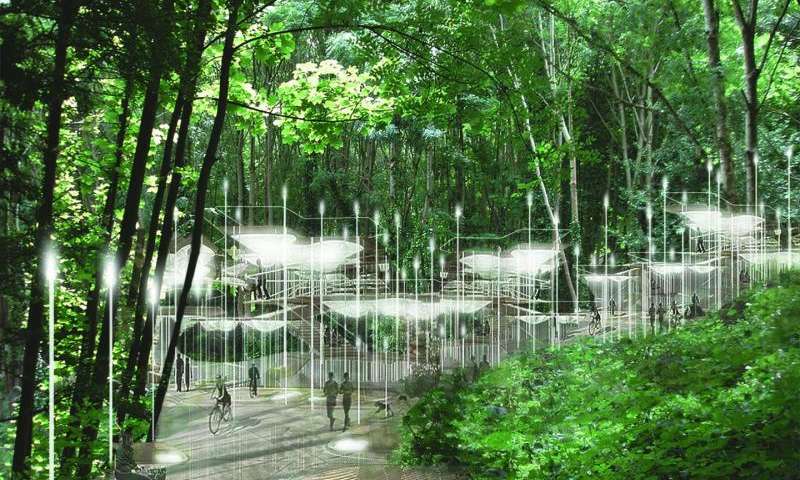
Imagine a world where your decomposing body produces electricity, in a cemetery.
A world where you literally live on after you die, as light.
A world where “a network of memorial vessels…transforms biomass into an elegant and perpetually renewing constellation of light which could illuminate pathways.”
Well, researchers at DeathLab, a part of Columbia University’s Graduate School of Architecture, Planning and Preservation, have imagined that world. And earlier this month they won a prize worth 5,000 British pounds that allows them to travel to the U.K. for a month long residency and attempt to make real the fruits of their imagination. DeathLab’s winning design is called Sylvan Constellation, and it will be tested out at the Arnos Vale Cemetery, in Bristol, England.
The prize was part of a contest organized by the University of Bath’s Centre for Death and Society, which is directed by Dr. John Troyer, who runs his own death blog, called the Death Reference Desk, and is often in the news for forward-thinking death-centric ideas and innovations.
“Some grieving families like the idea of their loved ones ‘giving back something,’” Troyer told the Guardian in 2011, concerning a proposal to use waste heat from a crematory in Redditch, England to run a nearby swimming pool. “I see that becoming predominant, and this research as an opportunity to do something innovative and respectful to the funeral mourning process.”
In this case, the innovation more centers around the cemetery process, which lately has become an unlikely arena for progressive design. Take the biodegradable burial pods developed by the Italian design company, Capsula Mundi, which were all the rage last year—at least on death-related social media channels. “Burial pods made of natural starch plastic nurture tree seeds as bodies break down,” reads the company’s press release about the objects. “The natural decomposition process feeds the tree above, and over time, burial spaces can be transformed from desolate graveyards into lush memorial forests.”
Biodegradable burial pods are just one example of how the cemetery of the future may not look like a cemetery at all. In Southeast Asia, where space is limited and expensive, large cities have already taken to burying their dead in glossy high-rise columbarium. In 2009, I wrote a Digital Dying blog about a six-star Singapore columbarium called the Nirvana:
The massive structure will be a luxurious home for the dead in a city-state increasingly short on space. Costs will range from $2,988 for a single-urn lot to as much as $26,888 for a double-urn compartment. “Hallways with sumptuous embellishment and dignity closures remind the visitors of a 5-star hotel, so they can abandon the fear and sadness but instead cherish the memories and remembrance,” reads the Nirvana website.
Then, of course, there is my favorite company, Celestis, which aims to make the entire Cosmos one vast human cemetery. Well, sort of. The Houston-based company has been attaching packets containing people’s cremated remains to space-bound rocket ships since 1997. “The official goal was to put a Spanish satellite into space but bolted to the rocket was a canister with the ashes of 24 people, in separate aluminum capsules,” I wrote for Digital Dying, back in 2009. “They contained the 1960s drug icon Timothy Leary, Star Trek creator Gene Roddenberry and a four year-old Japanese-American boy who apparently, ‘loved to talk about the stars.’…The cost for a capsule was $4,800.”
But the epicenter for earthly in-the-ground burial innovation may indeed lead back to Arnos Vale, where Dr. John Troyer has been working for some time to create an inspiring example of the future cemetery.
“In a nutshell,” Troyer explained in a 2012 Huffington Post article, the idea is to use “designers, multi-media artists, theatre performers, creative technologists, computer programmers, and app creators to transform Arnos Vale into an open source, end-of-life discussion and technology platform.”
The cemetery has been open for more than 170 years, holds approximately 300,000 deceased individuals and covers 45 acres near the center of the city of Bristol. There are regular wildlife tours, opera and music performances, and classes for jumping fitness, pilates, and yoga. And if the DeathLab folks can indeed carry out their fantastic idea, in the future their will also be dreamy lights run off the energy released from decomposing corpses.
“By encouraging Future Cemetery users to contemplate their own, inevitable deaths,” writes Troyer, “it became apparent that making death visible also meant finding a certain kind of liberation.”










Christine
Great idea!